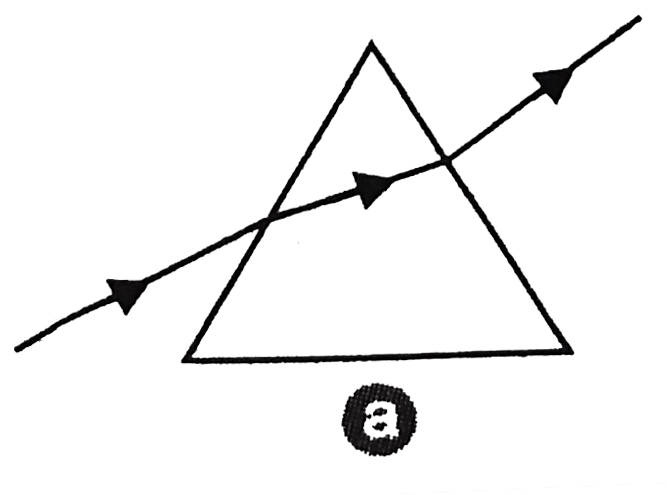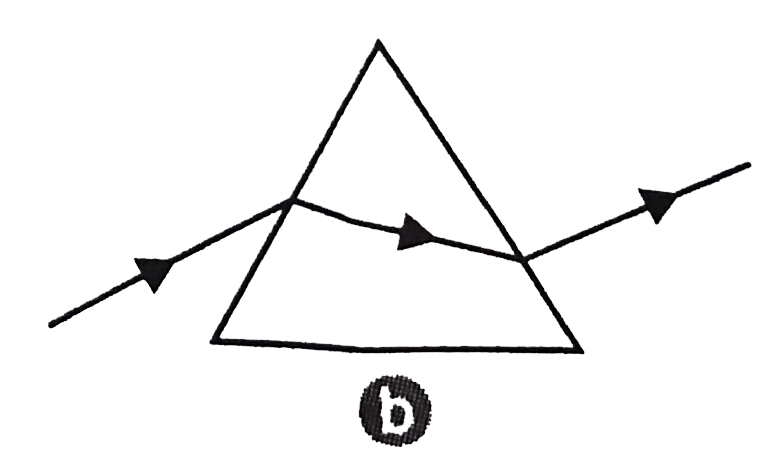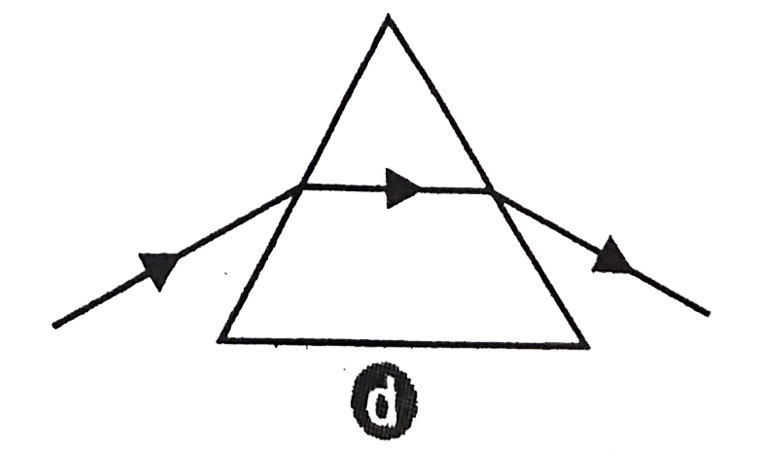Draw the course of rays through a glass prism ABC.
To draw the course of rays through a glass prism ABC, follow these steps:
1. Draw the Prism:
- Start by sketching the glass prism. Label the vertices as A, B, and C. The base AB will be the surface where the light ray enters, and the surface BC will be where the light ray exits.
2. Draw the Incident Ray:
- Draw a straight line approaching the prism from the left side. This line represents the incident ray. Label the point where this ray meets the surface AB as point P.
3. Draw the Normal Line:
- At point P, draw a normal line perpendicular to the surface AB. This line will help you measure the angles of incidence and refraction.
4. Mark the Angle of Incidence:
- Label the angle between the incident ray and the normal line as the angle of incidence (i).
5. Determine the Angle of Refraction:
- Since the light is moving from air (rarer medium) into glass (denser medium), it will bend towards the normal. Draw the refracted ray inside the prism, bending towards the normal. Label the angle between the refracted ray and the normal as the angle of refraction (r).
6. Draw the Emergent Ray:
- As the light ray travels through the prism and reaches the surface BC, draw another normal line at this point. The light ray will now move from the denser medium (glass) to the rarer medium (air), bending away from the normal. Draw the emergent ray and label the point where it exits as point Q.
7. Mark the Angle of Emergence:
- Label the angle between the emergent ray and the normal at point Q as the angle of emergence (e).
8. Label the Angles:
- Clearly label the angles of incidence (i), refraction (r), and emergence (e) on your diagram. Also, indicate the angle of deviation (D), which is the angle between the incident ray and the emergent ray.
9. Final Touches:
- Review your diagram to ensure all lines are straight, angles are marked, and the prism is clearly labeled.
- Start by sketching the glass prism. Label the vertices as A, B, and C. The base AB will be the surface where the light ray enters, and the surface BC will be where the light ray exits.
- Draw a straight line approaching the prism from the left side. This line represents the incident ray. Label the point where this ray meets the surface AB as point P.
- At point P, draw a normal line perpendicular to the surface AB. This line will help you measure the angles of incidence and refraction.
- Label the angle between the incident ray and the normal line as the angle of incidence (i).
- Since the light is moving from air (rarer medium) into glass (denser medium), it will bend towards the normal. Draw the refracted ray inside the prism, bending towards the normal. Label the angle between the refracted ray and the normal as the angle of refraction (r).
- As the light ray travels through the prism and reaches the surface BC, draw another normal line at this point. The light ray will now move from the denser medium (glass) to the rarer medium (air), bending away from the normal. Draw the emergent ray and label the point where it exits as point Q.
- Label the angle between the emergent ray and the normal at point Q as the angle of emergence (e).
- Clearly label the angles of incidence (i), refraction (r), and emergence (e) on your diagram. Also, indicate the angle of deviation (D), which is the angle between the incident ray and the emergent ray.
- Review your diagram to ensure all lines are straight, angles are marked, and the prism is clearly labeled.
Topper's Solved these Questions
- BOOK - PRADEEPCHAPTER - THE HUMAN EYE AND COLOURFUL WORLDEXERCISE - Higher Order Thinking6videos
THE HUMAN EYE AND COLOURFUL WORLD
- BOOK - PRADEEPCHAPTER - THE HUMAN EYE AND COLOURFUL WORLDEXERCISE - Value Based Question4videos
THE HUMAN EYE AND COLOURFUL WORLD
- BOOK - PRADEEPCHAPTER - THE HUMAN EYE AND COLOURFUL WORLDEXERCISE - (Additional)Long answer10videos
THE HUMAN EYE AND COLOURFUL WORLD
- BOOK - PRADEEPCHAPTER - SOURCES OF ENERGYEXERCISE - Mock Test20videos
SOURCES OF ENERGY
Similar Questions
(a) Draw a ray diagram showing the passage of light through a glass prism. Hence obtain a relation between the angles of deviation, incidence and emergence and angle of prism.
(b) Show that no ray can pass through a prism whose refracting angle A is greater than twice the critical angle for the material of the prism.View SolutionDraw the path of light ray passing through a prism. Label angle of incidence and angle of deviation in the ray diagram.
View Solution
Knowledge Check
- Question 1 - Select One
A student has drawn the following courses of rays through a glass prism, Fig. Which one represents the position of minimum deviation ?
A B
B C
C D
D
- Question 2 - Select One
When a ray passes through a prism,
Ait goes undeviatedBit remains parallel to the baseCit bends towards the baseDnone of these - Question 3 - Select One
Which of the following is the correct set - up of protractor for tracing the path of ray of light through a glass prism, for measuring the angle of incidence ?
A B
B C
C D
D
Draw course of rays through a compound microscope. Deduce an expression for its magnifying power. How can the magnifying power be increased ?
View SolutionWith the help of labelled ray diagram show the path followed by a narrow beam of monochromatic light when it passes through a glass prism.
View SolutionWhen white light passes through a glass prism
View SolutionThe path of light rays passing through a glass prism is BEST represented by ________
 View Solution
View SolutionWhile a white light ray, passes through a glass prism, the colour which disperses the least is
View Solution

